Group Dynamics 101 for Online Community Managers
Forming, Storming, Norming and Performing
A couple years ago I took a 10-month leadership course on small group facilitation to learn about how new groups form and achieve sustainability. The lessons were geared for physical offline groups, but my experience as an online group facilitator, including one of the largest social networks on Ning, convinces me that offline group models remain intact in the realm of social media as well. Web communities are comprised of real people, so we can expect basic human behavior patterns to permeate regardless of the medium in which they communicate.
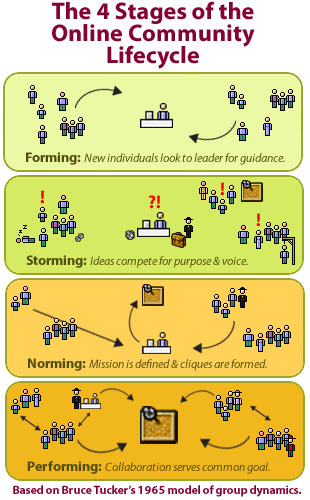
In 1965, Bruce Tucker proposed a model of group dynamics popularly known as Forming, Storming, Norming & Performing. In a nutshell, Tucker’s model encompasses several distinct stages, beginning from a group’s creation through its maturation and ultimate evolution or extinction.
Online community managers will find that Tucker’s work is still relevant today. These same stages of creation and growth are evident within all types of social media. If you moderate blog comments, forum posts, product reviews, news feedback, podcast networks or participate in social gaming or virtual worlds, Tucker’s model should be of interest to you. This is especially useful if you want insight into how your community can achieve sustainability.
The Lifecycle of Online Communities
Let’s look at each stage in sequence and consider how Tucker’s model applies to today’s online groups. As you read the descriptions, try to identify within which stage your online community currently exists. Is your community flourishing? Do you need to shift your community toward a later stage? Or retreat to an earlier one?
Update: I posted a series of reflection questions for each stage of the lifecycle.
Stage 1: Forming
The Group Is Born
In the early stages of group development, individuals rally behind a leader or core steering committee under a banner of broad challenge or opportunity. Enthusiasm is high, friendships form easily and people begin working on tasks. Everyone tends to be on their best behavior, but founding members operate independently with sense of autonomy and tend to be self-focused.
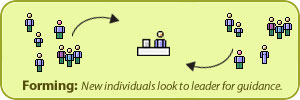 Successful groups leaders claim a position of authority by virtue of their experience, maturity, availability or simply because they are the ones laying the ground rules. Leaders frame guidelines on how the group will function and how its members will interrelate. This may be expressly written or socially implied through mission statements, codes of conduct and “leading by example.” Sharing the principles of group dynamics among group leaders and moderators can be very helpful in preparing people to encounter situations. (wink wink nudge nudge: share this article with your social media managers…)
Successful groups leaders claim a position of authority by virtue of their experience, maturity, availability or simply because they are the ones laying the ground rules. Leaders frame guidelines on how the group will function and how its members will interrelate. This may be expressly written or socially implied through mission statements, codes of conduct and “leading by example.” Sharing the principles of group dynamics among group leaders and moderators can be very helpful in preparing people to encounter situations. (wink wink nudge nudge: share this article with your social media managers…)
In the Forming stage, group leaders should also watch for early emerging leaders. When I instructed ROTC cadets in various drill camps and leadership schools, we closely observed individuals in order to fill positions as squad leaders and flight commanders within the first few hours of training. Extroverts tend to rise because they naturally make themselves known to others, but introverts are just as capable of leading if they are prompted or invited to do so.
You probably have a good idea about how you’d like to steer the early stages of your web community. Read these questions to see if you’re on track and where you might adjust.
Stage 2: Storming
Ideas and Personalities Compete to Be Heard
Every group encounters a period of identity & self awareness, where members debate essential objectives and problems and how they should behave individually and within groups. This is also a stage where leadership authority, knowledge, style and capability is most apt to be judged as either appropriate or unsatisfactory.
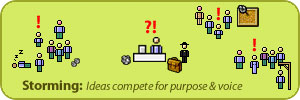 Groups can pass quickly through this stage or they can collapse for a number of reasons. If a leader abdicates their early role as guide, role model and referee, then stronger personalities are poised to set the behavioral tone. If purpose and objectives are muddled, then people will argue or undermine others to prove that their ideas are superior. “Good” people that were initially motivated, engaged and participating will leave the group.
Groups can pass quickly through this stage or they can collapse for a number of reasons. If a leader abdicates their early role as guide, role model and referee, then stronger personalities are poised to set the behavioral tone. If purpose and objectives are muddled, then people will argue or undermine others to prove that their ideas are superior. “Good” people that were initially motivated, engaged and participating will leave the group.
Another common community “soul killer” is the mouthy member that cannot help themselves from yapping. You know these people. They speak too often, for too long, and usually about issues that are irrelevant and self-serving. They overemphasize the minutia and obfuscate meaningful issues. They can make others uncomfortable by being too personal or act insensitively to others. They are not invited to speak by others, rather they tend to chime in on everything to imply deep personal wisdom, even if they just want to point out that they have no opinion on the matter. They moan, whine and grind their opponents. At the same time, these people can be overly welcoming and kind to new group members in an effort to win them to their side. Their immaturity is so evident, one is surprised to learn they aren’t a teenager (perhaps they are in netiquette terms).
If group leaders do not want to lose control of their group at such a critical stage, they need to act decisively to stifling, filibustering and flame wars. A good community manager brings a big bag of tricks with tactics in nuance, creativity, subtly and force. Like a good parent, group facilitators need to be ready to discipline, lead and teach. By applying a little parental love to your community, you can present an example of nurturing behavior amid disagreement and discord and move quickly past an otherwise painful growth spurt.
As your community vision extends to others, you inherently sacrifice messaging control. Learn from the mistakes of others, and look at the many brands handling this change successfully. Read these questions to help articulate new and persistent problems and suggest possible actions you can take.
Stage 3: Norming
Purpose, Cliques & Team Habits Form
Groups that reach the Norming stage enjoy clarity about their goals and objectives. That clarity helps to draw its members into service of the group, so harsh infighting and sabotage tends to fall away before this stage.
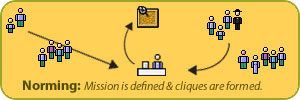 Individuals promote themselves less, unless the group’s objective involves self-promotion like business networks, alliances and chambers of commerce. Even then, members support each other through introductions into spheres of influence beyond the group.
Individuals promote themselves less, unless the group’s objective involves self-promotion like business networks, alliances and chambers of commerce. Even then, members support each other through introductions into spheres of influence beyond the group.
Members in this phase naturally attach to sub-groups of similar interests and tasks. Teamwork is stronger within sub-groups and sub-groups work more seamlessly with each other. Trust is built as people get to know each other and as the group accomplishes objectives. Collaboration is built through agreement on rules and the sharing of methods and tools.
Groupthink is a hazardous risk in the Norming stage, where new ideas and creativity are stifled in favor of process and status quo. Community leaders need to caution against group denial and echo chambers by recognizing their symptoms. They can avoid groupthink by remaining neutral and inviting fresh POVs when appropriate.
Hierarchy tends to flatten out during Norming compared to earlier stages. With a clear mission, collaboration and interpersonal issues worked out, leaders are able to assume more production tasks. Conversely, team leads may be established with more authority and control passed down and shared from Forming and Storming managers.
As your community matures, you will recognize healthy attachment among its members. Your community may operate fine in this stage with minor maintenance and attention. Or you might want to tighten cooperation and press for higher performance. Reflect on your community to see where it is healthy and where it needs attention.
Stage 4: Performing
Teamwork & Efficiency Prevail
A few groups will achieve the Performing stage where everyone seems to be firing on all pistons. Milestones are accomplished and objectives are routinely met. Experience is high, so communities become a rich knowledge base.
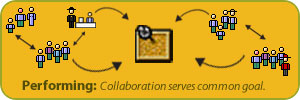 Teams become interdependent and work together fluidly without the drama borne from unnecessary conflict. Dissent does exist as long as it is channeled in a manner that is acceptable to the group. Supervision is minimal as people are held accountable to each other. Decision-making resembles more of a populist democracy than a dictatorship or republic. Community leaders tend to be highly participative.
Teams become interdependent and work together fluidly without the drama borne from unnecessary conflict. Dissent does exist as long as it is channeled in a manner that is acceptable to the group. Supervision is minimal as people are held accountable to each other. Decision-making resembles more of a populist democracy than a dictatorship or republic. Community leaders tend to be highly participative.
High performing teams may face circumstances that thrust themselves back to early stages. For example, the void left when early leaders leave a community can trigger a new Storming phase. I’m also reminded of the downtime caused by an explosion in the Planet’s H1 data center in Houston, an experience that sent its support forums into overdrive. Communities can experience these cycles of life over and over.
Browse the Big Boards to get a sense of what some of the largest communities on the web are doing. This is an outstanding resource for guerrilla social marketing.
Congratulations if your community has achieved a level of high performance. Take some time to think about how you can keep it going.
Post Mortem: Transforming and Mourning
Dealing with Change and Coping with Demise
Online communities are like living organisms that either adapt to internal and external changes or they will die. Think back to the big events in your life and they were almost always precipitated by change. Leaving home, starting school, starting a career, leaving a job, getting married and having kids all involve a death of sorts. One ceases to act or exist in one way when they change in another way. The same kind of death and renewal applies to groups.
I have seen leaders “kill” online communities and the reaction is not unlike real-world death. Feelings may not be as severe as losing a loved one, but members do experience a sense of loss like seeing your favorite TV show get canceled or saying goodbye to a friend that move’s away. This experience in virtual communities is not surprising considering the personal investment and real formation of human bonds.
Brand managers should consider this effect when transitioning campaigns or taking down social microsites at the end of a media flight (aka End of Life or EOL). If maintenance costs are truly inhibitive to effective ongoing community support, then the community should probably be taken offline. A diseased community can actually be harmful to a brand.
On the other hand, if long-tail benefits are evident and the group is operating at a strong Norming or weak Performing stage, the community may merit a plan for transition and ongoing maintenance, even if it only provides minimal support.
If you decide to maintain a community because participation and impressions justify the cost, then turn to your vendor partners for help in this transition. Good providers like Mango Mobile plan for EOL at the beginning of a campaigns. They are very flexible in either extending maintenance agreements or handing all assets back to the client for perpetual hosting. Another example is Blockdot in the advergaming space. They continue to support several widgets, social gaming and community applications well beyond the original EOL campaign schedule.
The life and energy of a social network benefits from early planning in the Online Community Lifecycle. Likewise, it benefits from planning at the end of life. Leaders can use Transforming and Mourning stages as an opportunity to publicly praise the group’s accomplishments. Individuals can be recognized, relationships can be acknowledged and achievements can be praised. People celebrate the birth of children and they gather to celebrate the life of those departed in death. The same kind of celebration can be introduced to the life and achievements of an online community.
Your community may be on the verge of temporary or permanent transition. Consider these issues to decide if you should change or pull the plug.
Final Thoughts
Community Managers that want to work on their community, and less time in it should study Tucker’s model of group dynamics in the context of an Online Community Lifecycle. Just as a sapling needs light, nutrients, water and fresh soil, an online community can be groomed for healthy sustainable growth.
Update: Read the accompanying article, How to Strengthen Your Online Community
9 replies on “The Online Community Lifecycle”
I have received direct feedback and praise for this article. Please share your feedback with others here and I’ll post updates.
I am also available to present this POV and share my experiences at conferences related to online community management. Contact me to discuss.
Hey buddy, I dropped in to check on you. What is going on in Austin!
Joel
Awesome post! Thanks for sharing!
i just wanted to chime in and say nice design.
Wazzup! I’ve hung around watching and reading for ages here. Just wanted you to know!
Hello. This is kind of an “unconventional” question , but have other visitors asked you how get the menu bar to look like you’ve got it? I also have a blog and am really looking to alter around the theme, however am scared to death to mess with it for fear of the search engines punishing me. I am very new to all of this …so i am just not positive exactly how to try to to it all yet. I’ll just keep working on it one day at a time Thanks for any help you can offer here.
Great info. I was not aware of Tucker’s work and find you reference to it and application of it to be informative and very helpful in my work. Thanks for a great article.
Anyone who reads your Online Community Lifecycle knows that donations are well deserved 🙂 Hi First time jumped here on your site, I found you on Yahoo. berley.
[…] Forming, Storming, Norming and Performing: https://shannonswenson.com/online-community-lifecycle/ […]